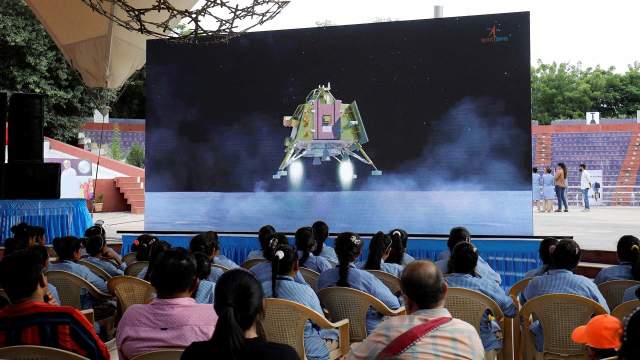Why is Russia interested in the success of the Indian space expedition
On August 23, the landing module of the Indian automatic station "Chandrayan-3" landed safely on the surface of the Moon. He landed near the South Pole — about the same place where two days earlier Russian experts had expected to land Luna-25. In the next two weeks, this device and the lunar rover delivered by it will conduct studies of the soil and exosphere of the Earth satellite. Experts note: despite the failure of the Russian expedition, our country is interested in the success of the mission of the Asian state, since in the future the Russian Federation will implement joint space projects as part of BRICS+ and other friendly international structures.
The mission is feasible
At 15:34 Moscow time on August 23, the lander of the lunar mission "Chandrayan-3" gently descended to the surface of the Moon. Thus, India became the fourth state after the USSR, the USA and China, whose artificial apparatus reached the surface of the Earth's natural satellite. And the first to land near the Southern Lunar Pole.
Two days ago, the Russian automatic station Luna-25 was supposed to land in approximately the same area. Unfortunately, as a result of an incorrect impulse during the transition to the lunar pre-landing orbit, the domestic device changed the flight path and crashed into the surface at high speed.

Layout of the Indian lunar automatic station "Chandrayan-3"
Image Source: Photo: Getty Images/Pallava Bagla
The previous attempt by the Indians to lower the lander to the lunar surface, which was undertaken in 2019, also ended in failure. Conclusions from the investigation of that accident were taken into account when designing the current expedition.
The "lunar ship" (this is how the name of the device is translated from Sanskrit) launched to its goal on June 14, 2023. It was launched into space by the LVM3 M4 launch vehicle. On August 5, Chandrayan-3 arrived in the orbit of the Moon, where, after another 12 days, the lander separated from it.
The most intense moment of the expedition was 17 minutes before the lander landed. At 15:17 Moscow time, he received the command to start the descent, after which he extinguished the horizontal speed from 6048 km / h to almost zero. Experts call this stage rough braking.
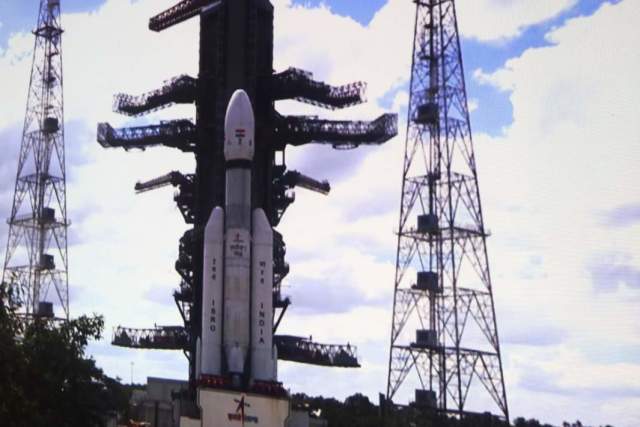
Indian rocket with automatic lunar station "Chandrayan-3" before launch at the Sriharikota cosmodrome
Image Source: Photo: Global Look Press/Dipa Chakraborty
Then the device turned, moving to a vertical position, and performed a descent. In technical language, this is a phase of subtle braking. During this period, the module was controlled by an integrated computer, oriented according to the readings of sensors and cameras installed on the device.
Even a minor mistake at this stage could lead to the collapse of the module and the failure of the entire mission. The lunar dust also acted as an opponent of the lander. These tiny particles created an exhaust plume around the device. Nevertheless, everything went well. Indian Prime Minister Narendra Modi watched the moon landing live.
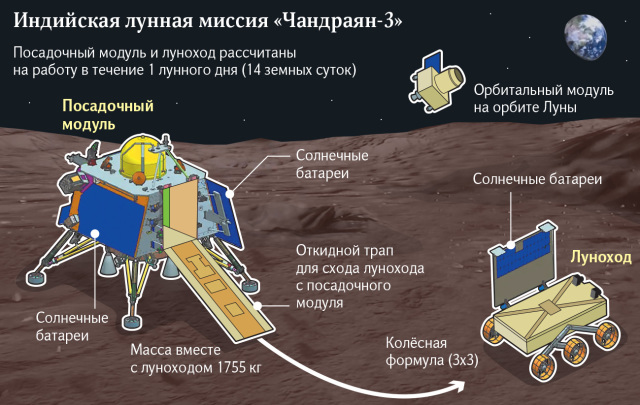 |
| Chandrayan-3. |
| Source: iz.ru |
Scientific work
In the near future, Chandrayan-3 will begin research work. The equipment of the lander will give him the opportunity to study the elemental composition and physical properties of regolith (lunar soil), to detect water particles under it, as well as to investigate the plasma-dust shell of the Moon.
The complex includes a six-wheeled lunar rover. It has two navigation cameras and two scientific instruments for conducting autonomous research at a distance from the stationary device. The work of Indian robots will continue for one lunar day — this is about 14 Earth days.
The grouping on the surface will be supported by the remaining propulsion module in orbit. It will provide a relay of the signal from the Moon to the Earth, and will also photograph the surface of the Earth's satellite.
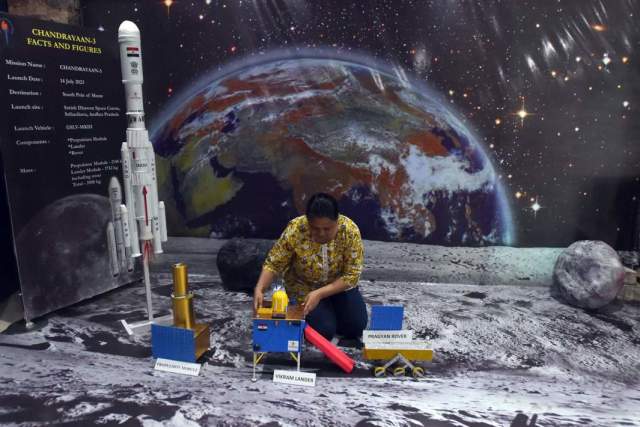
An employee of the Nehru Planetarium in Mumbai shows the mission of the Chandrayan-3 automatic lunar station on a mock-up
Image Source: Photo: Getty Images/Hindustan Times
— We expect the same results from the Indian lunar station that we hoped to get during the unsuccessful Luna-25 expedition. This is the analysis of the soil and the search for water particles there, — said the popularizer of cosmonautics Nicholas Oxman.
At the same time, the expert explained that, despite the luck of the Russian lunar expedition, the success of the Indian mission is extremely important for our country. He assured that the Indians will definitely share the materials received with their Russian colleagues for joint research. India is a friendly state with which we are developing cooperation in space programs. In particular, the Indian side consults with specialists from Russia in the design of the Gaganian manned spacecraft.
— The Indians have gained invaluable experience of landing at the South Pole of the Moon, where the terrain is difficult, there are many craters and depressions. This knowledge will be in demand by all countries that are preparing such expeditions — Russia, the USA, China, Israel, Japan and others. Scientists will also be able to see how the extremely harsh conditions of the lunar Polar region will affect the operation of instruments and equipment," said Alexander Bazilevsky, chief researcher at the Laboratory of Comparative Planetology of the Institute of Geochemistry and Analytical Chemistry of the Russian Academy of Sciences.
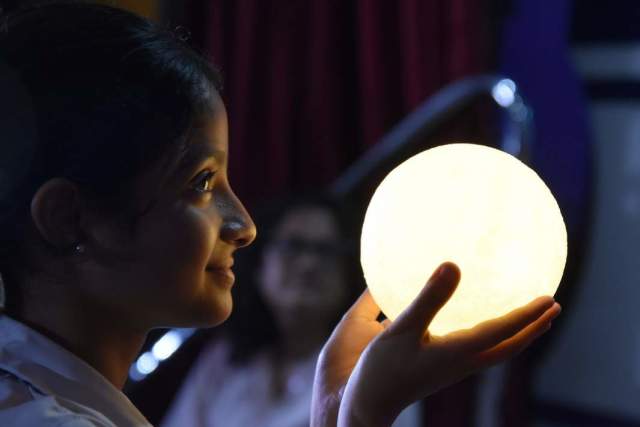
A schoolgirl with a mock-up of the Moon in the Industrial and Technological Museum of Birla before the launch of an Indian rocket with an automatic station "Chandrayan-3"
Image Source: Photo: Global Look Press/Biswarup Ganguly
According to him, one of the important results of the Indian mission may be the study of matter from the depths of the South Pole — Aitken impact basin — the largest crater on the surface of the satellite. It was formed as a result of the fall of a giant meteorite, which "loosened" the lunar surface to a depth of 200 km. If Chandrayan-3 manages to find and investigate this substance, scientists can learn a lot about the geology of the Moon.
Another important achievement of the Indians may be the study of a variety of helium in the lunar soil — the isotope of helium-3, Alexander Bazilevsky said. It accumulated on the surface of the Moon due to the "blowing" of its solar wind. It is believed that over billions of years, the Earth's satellite has accumulated enormous reserves of this element, which in the future can be used for a safe, environmentally friendly thermonuclear reaction.
— Russia is strategically interested in space exploration together with India and other friendly countries. This is the logic of history. No state, if we proceed only from national interests, has economically justified goals on the moon. Therefore, we need an international format, the wider the better," explained independent expert Andrey Ionin.
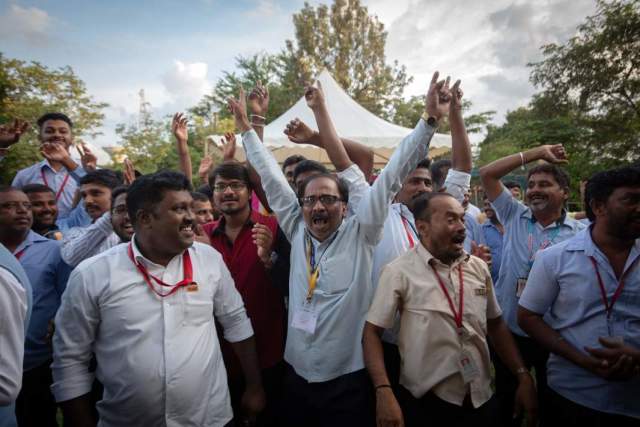
Employees of the Indian Space Research Organization rejoice at the successful landing of the Chandrayan-3 mission on the moon
Image Source: Photo: Getty Images/Abhishek Chinnappa
In this regard, the expert noted, the intensive development of the BRICS+ partnership (the unification of Brazil, Russia, India, China, South Africa and, in the future, a number of other countries) is so important. — "Izvestia"), which is now being observed. These countries proceed from the goal of creating an equal world order for all. At the same time, Moon exploration projects and other ambitious space tasks can become a positive content of the joint agenda for the member states of the commonwealth.
Andrey Korshunov
